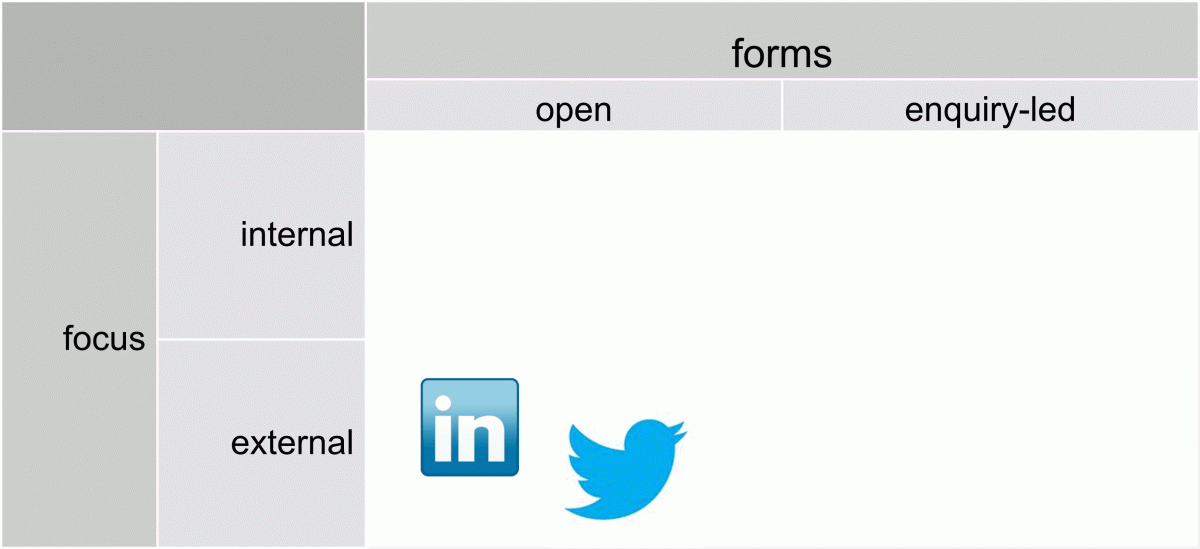By: Doug Collins
Organizations introduce web portals to help people share information and ideas. Time passes. Sites proliferate like kudzu strangling a pin oak. Their numbers keep people from finding the information they need and from engaging in the conversations that matter. Collaboration slows. What is the web gardener to do? In this article innovation architect Doug Collins explores how the practice of collaborative innovation can help organizations trim their proliferating portals.
The summer of 2012 placed the good citizens of the State of Ohio in an oven and baked us on high for several weeks. Midwestern optimists, we start May with green lawns and abundant hope. Come July, our lawns brown. Hope departs. Come September, we exit our air-conditioned shells to survey the damage.
The number, diversity, and vigor of the weeds that survive the heat never fail to impress and depress me. Did they arrive on the Chickweed Express? Did a disgruntled neighbor water the crabgrass at midnight?
The people who cultivate the collaborative garden for their organization can feel as glum when they survey their IT landscape. Their one well-manicured instance of SharePoint has turned into an overgrown thicket of sites. Half the people who managed the sites no longer maintain them. They’ve moved onto new jobs, careers, and lives. Users lose themselves in the labyrinth.
In this article I explore the possibilities of applying the practice of collaborative innovation to help the web gardener trim the creeping Kudzu of sites, spaces, and portals.
The conversation flows as follows:
- When Governance Is Not Governance
- The Right Tool for the Right Job
- Find What Matters
When Governance Is Not Governance
Portals proliferate in part because the IT group, which maintains the sites, and the business group, which applies the capability to address a challenge, speak different languages.
The IT group speaks the language of technology: site security and availability, for example. The business group by comparison speaks the language of intent: how might this capability help us solve a critical business problem, for example. Their interest extends no further than that immediate problem, however.
The organization at large experiences a “tragedy of the commons” as a result. Both parties have a vested interest in weeding the commons. Neither party has the complete mandate to wield the clippers.
One solution? Discard conventional governance. Invite self-governance by posing the critical question as an innovation challenge to the larger community of IT and business stakeholders. Focus on the ends, not the means, for the collaborative commons. Examples of challenge questions follow:
- How might we minimize the time people need to find information across the enterprise?
- How might we more fully realize the power that dialogue brings to the organization?
- How might we maximize the level of employee engagement?
Inviting people to share their aspirations for the collaborative environment helps the organization arrive at an effective model of self-governance.
The Right Tool for the Right Job
Misapplying web applications contributes, too, to the weedy state of the collaborative commons. People do not know what they like: they like what they know. As a result, they apply the same tool to multiple jobs, no matter how applicable, once they become comfortable administering the resource.
One solution? Give people a way to see the whole—in this case, the collaboration space at large—to help them choose the right tool for the right job.
I recommend taking a page from the blueprint that informs Innovation Architecture. Share the middle section of the blueprint, forum, with the community (figure 1). Help people build a common language around collaboration as a first step towards helping them identify the right tool for the right job.
Figure 1: depicting the collaborative innovation space or forum
By definition…
- Internally focused collaboration engages people within the enterprise
- Externally focused collaboration engages people within and outside the enterprise
- Open forms of collaboration give people space to contribute ideas and knowledge outside the context of a specific question
- Enquiry-led forms of collaboration give people space to contribute ideas and knowledge in response to a specific question
At this stage in the evolution of web communities, “seeing the whole” means exploring what is happening outside the walled, padlocked gardens of internally focused portals.
People who work for large organizations can now, for example, more nimbly navigate amongst contacts on LinkedIn than they can through their internal resources. Why? The LinkedIns of the world decided to serve the user from day one. The IT group, by contrast, serves two masters: the user and the organization at large. The consumerization of IT is well underway. Externally focused forms of collaboration outpace their internal complements on a couple fronts (figure 2).
Figure 2: the line between internal and external blurs
Powerful challenge questions might be…
- How might we increase the level of authentic engagement within the organization by pursuing internally focused collaborative innovation?
- How might we maximize externally focused forms of collaborative innovation by applying resources such as LinkedIn and Twitter?
Find What Matters
New clients sometimes observe to me that the organization has “legacy” ideas or resources. What should they do with them?
Often, too, the client observes that nobody within the organization has touched the assets in question for over a year.
This exchange serves as a teachable moment for the organization: ideas, conversational threads, and knowledge resources, absent active engagement by living, breathing people, have no value. Dialogue—conversation amongst community members—is the activity that enables organizations to realize the potential value a given asset may hold.
To this end, posing the following types of questions in the form of an innovation challenge can serve to invite people to decide whether they see value in a particular part of the web environment—or whether that branch can be pruned without incident.
- What possibilities do you see in exploring the following web resources further?
- What reservations do you have in taking the following web resources offline?
If people see no possibilities (no affirmative response), then the knowledge asset can be safely pruned.
Parting Thoughts
IT groups intend the best when they introduce web resources to the organization. Left to their own devices, people will, with their own best intentions, grow the resources to the point where nobody can find information or collaborate. At this stage, the IT group takes the draconian step of disabling the very services they introduced or pursues a policy of benign neglect.
Instead of watching the weeds overwhelm the web garden, IT groups can apply the same practice of collaborative innovation to achieve balance. Invite governance of the commons. Help the community see the whole. And, express authentic leadership in helping people realize that dialogue represents the end game in the knowledge economy.
By Doug Collins
About the author:
 Doug Collins is an Innovation Architect who has specialized in the fuzzy front end of innovation for over 15 years. He has served a variety of roles in helping organizations navigate the fuzzy front end by creating forums, venues, and approaches where the group can convene to explore the critical question. As an author, Doug explores the critical questions relating to innovation in his book Innovation Architecture, Practical Approaches to Theory, Collaboration and Implementation. The book offers a blueprint for collaborative innovation. His bi-weekly column appears in the publication Innovation Management.
Doug Collins is an Innovation Architect who has specialized in the fuzzy front end of innovation for over 15 years. He has served a variety of roles in helping organizations navigate the fuzzy front end by creating forums, venues, and approaches where the group can convene to explore the critical question. As an author, Doug explores the critical questions relating to innovation in his book Innovation Architecture, Practical Approaches to Theory, Collaboration and Implementation. The book offers a blueprint for collaborative innovation. His bi-weekly column appears in the publication Innovation Management.


